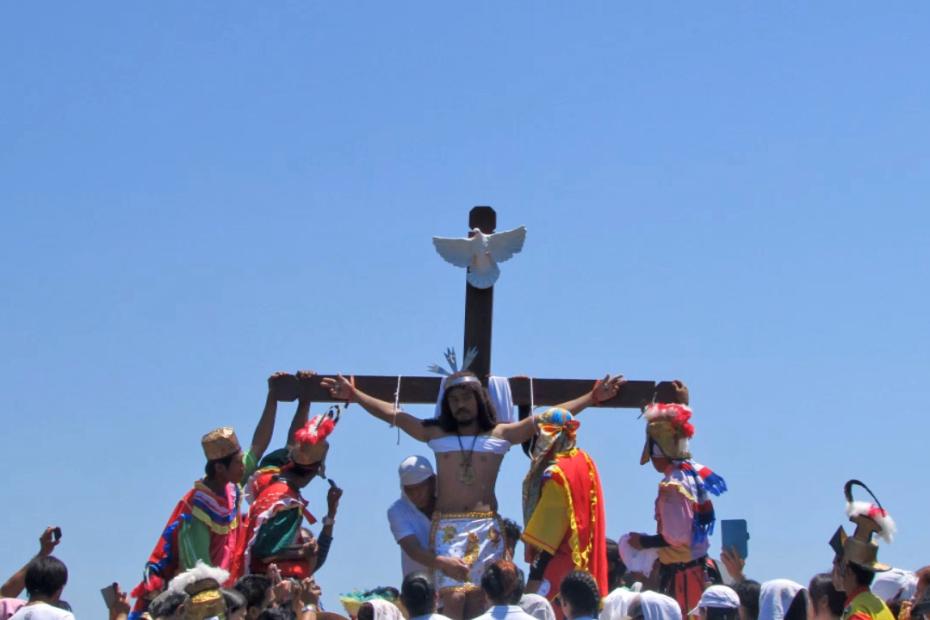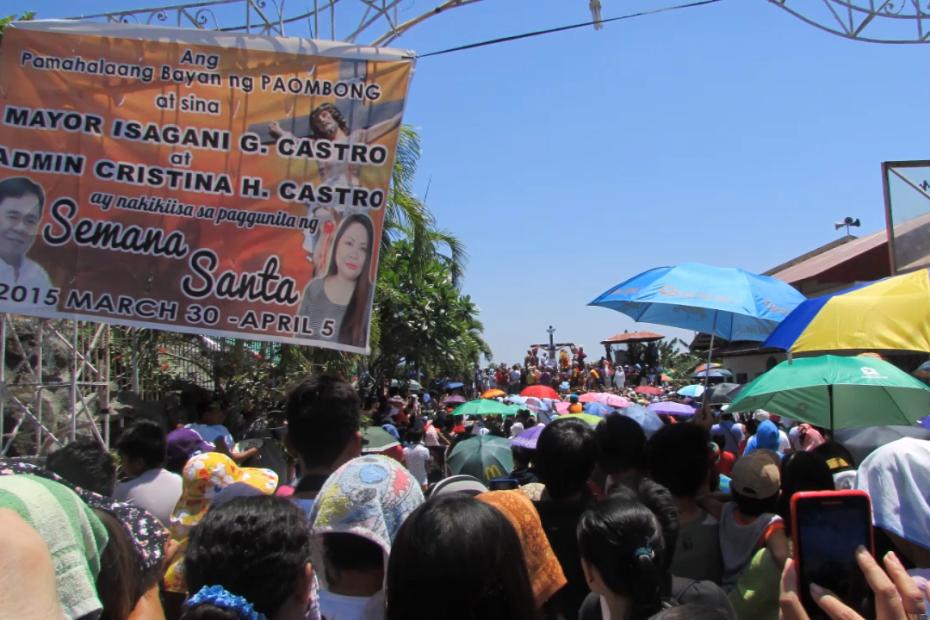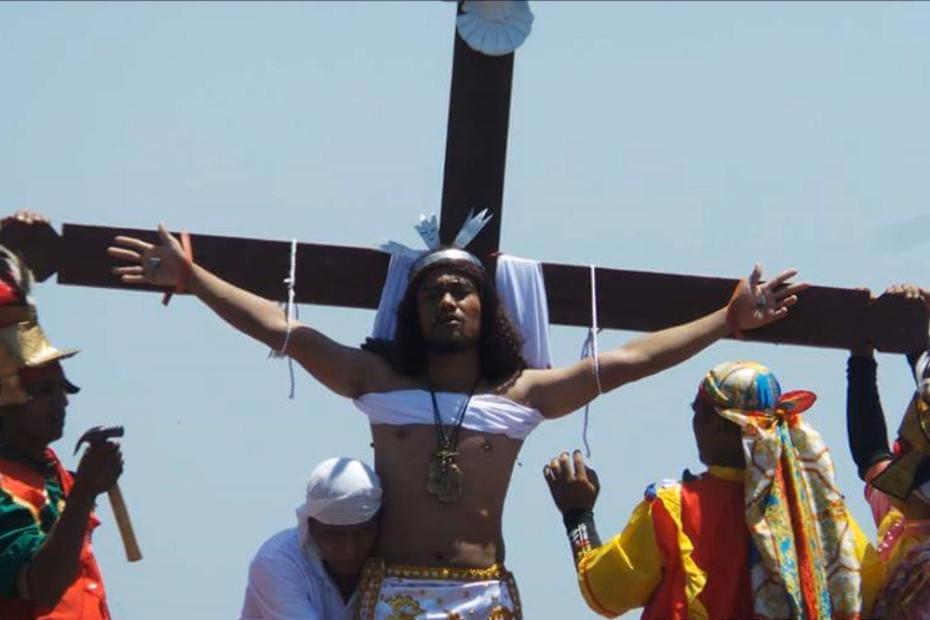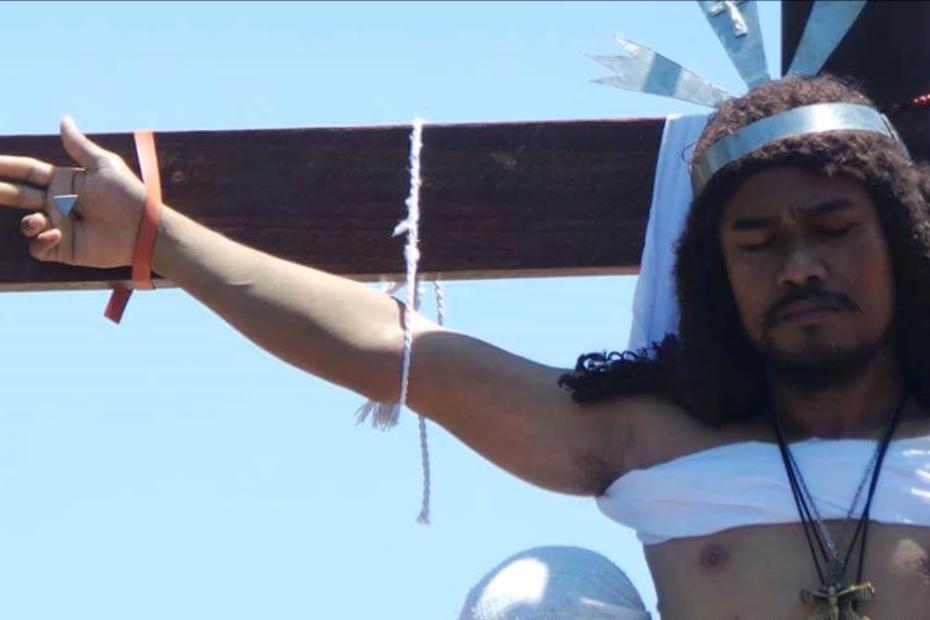Kapitangan, a barangay1 in Paombong, Bulacan province, is known in the Philippines as the site of one of the bloodiest Senakulo, or public reenactments of the Passion during Holy Week, particularly on Good Friday.2 Residents of the area have long claimed that the ancient local image of the Santo Kristo, or Crucified Christ, has miraculous healing power. On Holy Wednesday each year, the image is bathed in oil, and that oil is distributed free to pilgrims as to bring healing power to those in need.
During Holy Week at Kapitangan, male penitents flail themselves bloody, and volunteer penitents are crucified (though not to the point of death) on a cross. Though the Church prohibits the most extreme of these acts, they take place outside of Kapitangan’s Santo Kristo Catholic chapel, which is home of the miraculous Santo Kristo crucifix. Significant numbers of believers have come to witness the penitential spectacle since it began in 1977.
Some men who have themselves nailed to a cross are penitents fulfilling a panata — a vow — in atonement for their sins, or do so as a sacrificial act of thanksgiving for favors granted. Others claim that God called them to this mission, and undergo this suffering so that they can be given the divine power of healing in return. They come here because the Santo Kristo is locally considered as the patron saint of healers.
During a visit during Holy Week in 2015, the place was brimming with people as early as 9 a.m. — local and tourist, penitents, devotees, pilgrims and bystanders anxiously waiting for start of the crucifixions. Penitents who are to be crucified walk barefoot under the hot sun carrying a wooden cross on their shoulders, while other penitents walk alongside whipping their backs bloody with a whip made of sticks. On the “Calvary,” a concrete platform behind the chapel, penitents are nailed to a 12-foot-high wooden cross, wearing only a piece of cloth and a crown of thorns in imitation of Jesus. Four-inch-long nails soaked in oil and alcohol were used in each hand, and a five-inch long spike in his feet. Unlike the actual crucifixion, the penitent had a support for his feet and ties for his hands, to prevent suffocation, but the nails were quite real.
A group of Mambabasa chanted the Pasyon — Passion — as each cross, with the penitent on it, was held up for a few minutes or as long as an hour. Penitents often lost consciousness from excruciating pain, intense heat and dehydration. When the cross was lowered, the nails were removed using a vise-grip and the penitent was brought inside the church to rest and pray. One penitent reported that it was his way to acquire healing power, through complete submission to God. He vowed to continue this mission as long as God wanted him to continue and as long as his body allows it.
Crucifixion at Kapitangan Paombong, Bulacan
Not all penitents are men.3 Lucy - Luciana Reyes - was the first woman crucified there, in 1977, when she was 18, against the strong wishes of family and friends. In a 2015 interview,4 she recalled that she was very sick that time, and had an apparition of Sto. Kristo commanding her to do carry the cross and be crucified. She claims that the Santo Niño took over her body during the crucifixion, allowing her to survive it. Today, she still has the nails, and conducts healing sessions from a chapel at her home. Twelve women followers live with her and care for her, but she remains unmarried because she says that the Santo Niño will not allow it. Together they pray for the country, especially in times of calamity. She says that the Santo Niño has told her that her final mission is to visit Jerusalem and walk the way of Jesus' crucifixion.
Read more
For a more extensive discussion of the origins of the Kapitangan crucifixions, including more on the story of Lucy Reyes and the links between the crucifixions and healing, see:
P. J. Bräunlein, "Negotiating Charisma: The Social Dimension of Philippine Crucifixion Rituals," Asian Journal of Social Science 37 (2009): 892-917.
- 1A barangay is the smallest unit of political governance in the Philippines, a political sub-area of a city or town
- 2In Tagalog, Senakulo is sometimes spelled as Sinakulo as well. It derives from the Spanish word for Cenacle.
- 3 During his field research from 1996-1998, P. J. Bräunlein notes that those nailed to the cross were "mostly women." P. J. Bräunlein, "Negotiating Charisma: The Social Dimension of Philippine Crucifixion Rituals," Asian Journal of Social Science 37 (2009) 892-917.
- 4Interview between Luciana Reyes and Maricel Eballo, Kapitangan, Paombong, Bulacan, May 1, 2015



